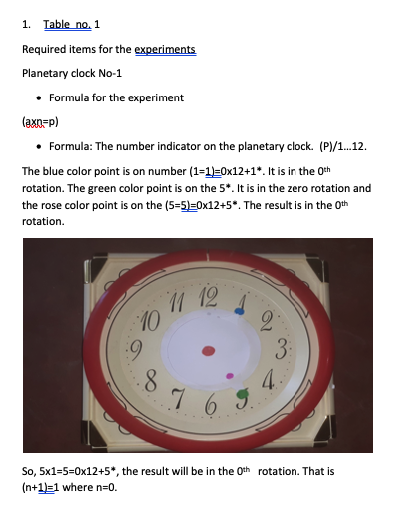Practical Exploration of Mathematical Tables
Summary:
The “Mission Planetary Clock” introduces an innovative approach to teaching and understanding mathematical tables. This method explained practically using a planetary clock, aims to revolutionize how mathematics and other subjects are taught from primary school to PhD level.
The book begins with an introduction to the significance of mathematical tables, as they form the basis of various subjects. Through extensive research, the author has developed an educational instrument called the Planetary Clock, which aids in explaining mathematical tables.
Each table from 1 to 50 is practically explained using the Planetary Clock. For example, Table No. 1 is explained as follows: The blue colour point on the clock corresponds to the number 1, which is in the 0th rotation. The green colour point indicates the 5th rotation, and the rose colour point represents the number 5, which is in the 0th rotation as well. Thus, the result of 5 multiplied by 1 is 5, also in the 0th rotation.
Similarly, Tables 2 to 6 are explained following the same pattern. The Planetary Clock helps determine the rotations associated with each number and aids in calculating the results of the multiplication.
This practical approach allows students to visualize and comprehend mathematical tables more engagingly. The “Mission Planetary Clock” applies to mathematics and can be extended to subjects like physics, chemistry, and geography.
By incorporating the Planetary Clock methodology, this educational approach provides a unique perspective that simplifies complex mathematical concepts and enhances the overall learning experience.
Excerpt:
Practical Exploration of Mathematical Tables
1. Table no. 1
Required items for the experiments
Planetary clock No-1
• Formula for the experiment
(axn=p)
• Formula: The number indicator on the planetary clock. (P)/1…12.
The blue colour point is on number (1=1)=0x12+1*. It is in the 0th rotation. The green colour point is on the 5*. It is in the zero rotation, and the rose colour point is on the (5=5)=0x12+5*. The result is in the 0th rotation.
So, 5×1=5=0x12+5*, the result will be in the 0th rotation. That is (n+1)=1 where n=0.


Reviews